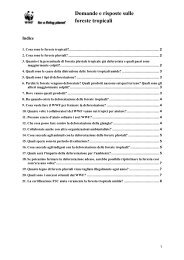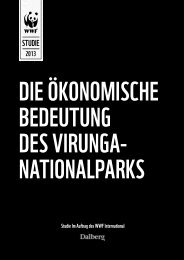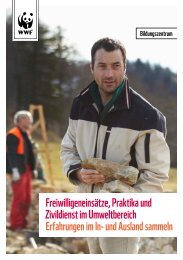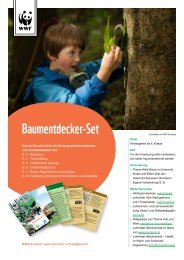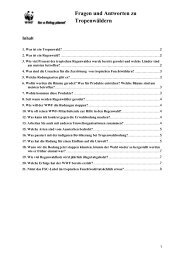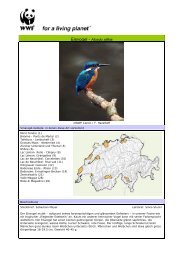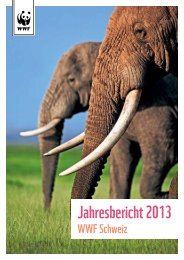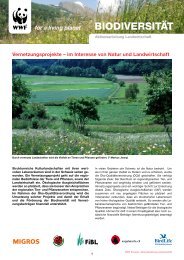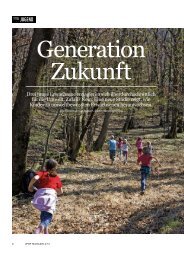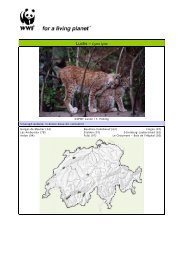Life is Biodiversity
Life is Biodiversity
Life is Biodiversity
Create successful ePaper yourself
Turn your PDF publications into a flip-book with our unique Google optimized e-Paper software.
Species fact sheet:<br />
<strong>Life</strong> <strong>is</strong> <strong>Biodiversity</strong><br />
Come with us on a journey. Close your eyes.<br />
Where shall we begin? The lush green dense<br />
forests of Central Africa where we hear the<br />
sounds of birds high in the trees, the shrill<br />
cries and sounds of monkeys, a d<strong>is</strong>tant plod<br />
and sway of shy forest elephants and the<br />
low buzz of insects in the air.<br />
Forest canopy in the Congo Basin rain forest.<br />
© WWF-Canon / Martin Harvey<br />
Or shall we move to the arid dry plains of<br />
Namibia where a lone rhino looms on the<br />
horizon and we unexpectedly come across<br />
an ambling herd of desert elephants as the<br />
sun sets and water holes beckon.<br />
Black rhinoceros, Namibia.<br />
© WWF-Canon / Frederick J. Weyerhaeuser<br />
In Kenya, it’s hot, dry and farmers look at their crops, desperate<br />
for the maize to ripen as hunger nips the air. Even as<br />
expectation r<strong>is</strong>es, hungry elephants smell the maize from ten<br />
kilometers away and herald an unwelcome arrival. Overnight an<br />
entire year’s income can be consumed or destroyed.<br />
African elephants, Kenya. © WWF-Canon / Martin Harvey<br />
1
Orang-utan, Borneo, Indonesia.<br />
© WWF-Canon / Alain Compost<br />
Eastern lowland gorilla, Central Africa.<br />
© WWF-Canon / Martin Harvey<br />
What about tree-dwelling apes that are victims of war<br />
and civil strife? Eaten, kidnapped, traded illegally, losing<br />
their homes and last refuge — we may lose them within the<br />
next 20 years.<br />
Or pr<strong>is</strong>tine beaches juxtaposed with high r<strong>is</strong>e development<br />
and tour<strong>is</strong>t hotels, oil exploration, shanty towns, and<br />
f<strong>is</strong>hing communities eeking the last remaining resources<br />
from our depleted seas. Where mammoth trawlers scrape<br />
ocean beds and fine mesh nets swing from boats trapping<br />
everything in their wake. Or where lines hang deep in the<br />
water and hook thousands of turtles along with the f<strong>is</strong>h<br />
that are targeted — immobile, powerless, and dead or<br />
dying.<br />
Africa — desperately poor in many places and where<br />
wildlife and people are competing for space, food, and for<br />
life. Resources, food, shelter, and water are scant and<br />
sickness and famine are frequently woven into the fabric of<br />
everyday survival.<br />
Shall we go to Asia? Feel the hot humid air, see the<br />
colours of the jungle, the smog and bustle of cities, the<br />
grind of machinery, and development heavy in the air.<br />
Asia, hothouse of wonders, of rich and wondrous<br />
biodiversity. Where pandas lazily move amongst the<br />
bamboo and orang-utans peek out from the tops of trees.<br />
The regal tiger, a flash in the undergrowth, glimpse of<br />
orange and black. Hunted, reviled, adored and feared.<br />
Valued for its skin, its parts, its worth as medicine but now<br />
driven to near extinction.<br />
Imagine lumbering elephants becoming enemies and<br />
violence streaking the air as we close in to fight for space<br />
and food. Look over Sabah in Malaysia — and the uniform<br />
lines of oil palm plantations that have usurped the virgin<br />
forests. Boxes and straight lines on the world’s surface.<br />
Where forests in Indonesia burn every year and cloud the<br />
skies with toxic black smoke, filling lungs with pain and<br />
causing confusion.<br />
Think of Asian rhinos — some of the rarest and most<br />
reclusive mammals in the world that now hover on the<br />
brink of extinction. H<strong>is</strong>torically hunted for their horn, a<br />
prized ingredient in traditional Asian medicines, they are<br />
Leatherback turtles, French Guiana.<br />
© WWF-Canon / Roger LeGuen<br />
Black rhinoceros, Africa.<br />
© WWF-Canon / Martin Harvey<br />
now devastated by the destruction of their lowland forest<br />
habitat.<br />
Home to some of the world’s most prized jewels, we are<br />
destroying our planet’s natural heritage at an<br />
unprecedented rate. We pr<strong>is</strong>e and pluck what we can from<br />
the earth, and poach plants or animals for international<br />
trade — poaching and illegal trade that harms species and<br />
local people.<br />
Here in Southeast Asia — feel the buzz of a major hub for<br />
trade in wildlife, a place which acts as a supplier,<br />
consumer, and a transit point for plants, animals, timber,<br />
reptile skins, plant extracts, and live birds. See the volume<br />
of trade and gasp. How long can that be sustainable? How<br />
much goes unnoticed, how many tonnes slide away<br />
silently in vessels and airplanes across the ocean?<br />
Want to move on? Look up at the mighty trees and<br />
breathe in as we come to the Amazon. The Latin America<br />
and the Caribbean region embraces almost half of the<br />
world's diversity of plant and animal species and half of<br />
the world's tropical forests. Hear the roar of the saw and<br />
the creak of falling timber.<br />
Where stealthy black jaguars move in the dense forests<br />
only to find their home gone from one day to the next.<br />
Where magical spectacled bears sneak onto farms and<br />
raid crops in their former homes, making pests of<br />
themselves and frightening communities.<br />
Let us explore and wonder as dolphins peek their heads<br />
out from fresh water tributaries and enormous ancient<br />
turtles struggle inland to beaches to lay their eggs in a<br />
trance and then head off to the oceans towards the moon.<br />
Crossing the world, these mighty creatures journey<br />
thousands of kilometers to Asia and Africa, following their<br />
ancestral routes, now blocked by shipping fleets and walls<br />
of f<strong>is</strong>hing nets.<br />
Look out to sea. Here too see the never ending rows of<br />
boats, pollution, dredging, and the clearing of wetlands,<br />
mangroves, and salt marshes. And here almost one-third<br />
of people live in poverty, mostly indigenous communities,<br />
lacking education, health, and housing.<br />
Bengal tiger, Asia.<br />
© WWF-Canon / Martin Harvey<br />
Greater one-horned rhino, Nepal.<br />
© WWF-Canon / Michel Gunther<br />
2<br />
Jaguar, Brazil.<br />
© WWF-Canon / Y.-J. Rey-Millet<br />
Bottle-nosed dolphin, Honduras.<br />
© WWF-Canon / Chr<strong>is</strong> Martin Bahr
WWF Snow leopard anti-poaching brigade, Mongolia. © WWF-Canon / Hartmut Jungius<br />
Come to Europe now… From the mountainous icy<br />
terrains in the Ukraine and the flat snowy lands in the<br />
Russian Far East, to the warm balmy beaches in the<br />
Mediterranean. Or the high-r<strong>is</strong>e apartments, the stream of<br />
cars, and the constant no<strong>is</strong>e and bustle of cities. To the<br />
lone wolves that have been vilified as enemies and the few<br />
big cats that ex<strong>is</strong>t amongst us in <strong>is</strong>olated populations. Or<br />
the tour<strong>is</strong>t enclaves where we build and destroy the space<br />
where turtles nest and birds migrate. From Romanian<br />
bears and Iberian lynx, to the Amur tiger, freshwater f<strong>is</strong>h,<br />
and lone leopards, here too, much <strong>is</strong> d<strong>is</strong>appearing before<br />
our eyes.<br />
It’s not an easy path to tread but one we have to negotiate.<br />
We live in a world that <strong>is</strong> changing hour by hour, where our<br />
impact on the earth <strong>is</strong> heavy and where people urgently<br />
need ways to live with species, side by side — not just for<br />
their sake but for ours. For if we lose our species, we lose<br />
ourselves in a world we have destroyed.<br />
• Less f<strong>is</strong>h in the sea—less food for survival.<br />
• A lack of clean water<br />
• Fewer opportunities for livelihoods—for health,<br />
education, and a better life<br />
• A lack of forest resources such as food, or plants for<br />
medicine<br />
• And in the long term, less income for communities<br />
Let’s retrace our steps. WWF and its partners have a<br />
number of projects around the world to reduce<br />
human-animal conflict and improve the livelihoods of the<br />
people affected. These projects range from traditional<br />
approaches such as compensation schemes to the<br />
development of novel strategies which address the root<br />
causes of these conflicts. The solutions are often specific<br />
to the species or area concerned, and are often creative<br />
and simple.<br />
An important aspect of the work <strong>is</strong> that it benefits both the<br />
animals and local human communities, and <strong>is</strong> developed<br />
through and with these communities. The idea <strong>is</strong> to find<br />
MSC-certified f<strong>is</strong>hermen Baja, Mexico. © WWF-Canon / Gustavo Ybarra<br />
solutions that lead to the mutually beneficial co-ex<strong>is</strong>tence<br />
of people with wildlife. In most cases, the work has often<br />
led to people being more enthusiastic and supportive of<br />
conservation, and has demonstrated that people can live<br />
alongside wildlife while developing sustainable livelihoods.<br />
WWF recogn<strong>is</strong>es the need to take conservation beyond<br />
the borders of national parks and nature reserves into<br />
entire landscapes by integrating the protection,<br />
restoration, and sustainable use of land. The essence <strong>is</strong> to<br />
conserve the broad ecology of species and their<br />
behaviours in their natural habitat, not just individual<br />
populations or individual animals.<br />
WWF’s landscape conservation goal aims at connecting<br />
protected areas through natural corridors and protecting<br />
them and managing them effectively. To do th<strong>is</strong>, field<br />
managers and policy-makers must employ ‘peoplefriendly’<br />
conservation approaches that will allow humans<br />
to coex<strong>is</strong>t harmoniously with species in these landscapes.<br />
Th<strong>is</strong> ambitious venture must involve local communities,<br />
local authorities and other stakeholders at different levels<br />
of planning, policy-making and implementation.<br />
Through its global network and especially the work of<br />
TRAFFIC, operated as a joint programme by and between<br />
WWF and IUCN-The World Conservation Union, WWF<br />
works to stop illegal and unsustainable wildlife trade. Th<strong>is</strong><br />
includes sound scientific and technical information<br />
collection and analys<strong>is</strong>; supporting enforcement of CITES,<br />
the best-known international body for regulating<br />
international trade in wildlife; promoting new laws and<br />
regulations; helping with anti-poaching activities; working<br />
with local communities to find more sustainable ways of<br />
using their resources; capacity building; and public<br />
education.<br />
Above all, the aim <strong>is</strong> to encourage sustainability in wildlife<br />
trade, by informing all those involved, including the general<br />
public, about the environmental harm illegal and<br />
unsustainable wildlife trade can cause, and by providing<br />
guidance and support to counteract it.<br />
Anti-poaching brigades, Bikin River, Russian Federation.<br />
© WWF-Canon / Vladimir Filonov<br />
Rhinoceros radio tracking, Nepal.<br />
© WWF-Canon / Michel Gunther<br />
3<br />
Woman carrying fuelwood, Sumatra, Indonesia.<br />
© WWF-Canon / Mauri Rautkari
By influencing national, regional, and international policy<br />
and leg<strong>is</strong>lation that integrate with the field, we hope to<br />
ensure that on-the-ground conservation meets the needs<br />
of the communities who must take on custodianship of<br />
natural resources, as well as ensuring the long-term<br />
management of species and their habitats.<br />
Dolphins, small whales, marine turtles, seabirds, sharks,<br />
juvenile f<strong>is</strong>h, f<strong>is</strong>h with no commercial value, corals …<br />
every year, billions of these so-called “non-target species”<br />
are caught by industrial f<strong>is</strong>hing boats then d<strong>is</strong>carded dead<br />
or injured back into the ocean. But proven solutions do<br />
ex<strong>is</strong>t to reduce bycatch — and still benefit local f<strong>is</strong>hing<br />
communities and industrial f<strong>is</strong>heries—and others are<br />
waiting to be d<strong>is</strong>covered. WWF and its partners are<br />
working around the world to develop, test, and implement<br />
new f<strong>is</strong>hing gear and to change the way f<strong>is</strong>heries are<br />
managed so that fewer non-target species are caught.<br />
WWF and its partners are also working to strengthen<br />
leg<strong>is</strong>lation on bycatch and to ra<strong>is</strong>e consumer awareness<br />
about sustainably caught f<strong>is</strong>h.<br />
The aim <strong>is</strong> to encourage sustainability in the world’s<br />
f<strong>is</strong>heries, by informing all those involved — f<strong>is</strong>hers,<br />
consumers, the seafood industry, and governments —<br />
about the enormous environmental harm that bycatch <strong>is</strong><br />
causing, and by providing practical solutions and support<br />
to counteract it.<br />
WWF <strong>is</strong> committed to long-term action to address and<br />
reverse the alarming trend of species declines and<br />
extinction.<br />
Species as part of a wider context<br />
Although WWF's Global Species Programme <strong>is</strong> ambitious,<br />
the conservation gains are also correspondingly high in<br />
terms of the animals themselves and their habitats, as well<br />
as the many thousands of other species and local<br />
livelihoods that will benefit from efforts to conserve these<br />
species.<br />
By conserving threatened species in their natural habitat,<br />
WWF also ensures that the variety of life-supporting<br />
ecological services that are found there, continue to<br />
function for the benefit of both humans and wildlife.<br />
The decline of a species <strong>is</strong> very often a strong indicator of<br />
degradation in the local habitat, which can also negatively<br />
impact the biodiversity of that area.<br />
Giant panda, China.<br />
© WWF-Canon / Michel Gunther<br />
In practical terms…<br />
When conserving species, we often see an associated<br />
benefit that contributes to the greater environmental<br />
picture by:<br />
1. Increasing the number, size, and connectivity of<br />
protected areas<br />
2. Encouraging interaction and debate on <strong>is</strong>sues that<br />
affect humans and nature<br />
3. Increasing awareness amongst governments to take<br />
environmental <strong>is</strong>sues seriously, by encouraging their<br />
participation in international conventions such as CITES<br />
4. Improving enforcement of measures that help to<br />
increase the sustainability of wildlife trade<br />
5. Creating opportunities for tour<strong>is</strong>m to develop in a way<br />
that benefits both local communities and the<br />
environment—species and their habitats<br />
6. Ass<strong>is</strong>ting local engagement with the environment in a<br />
way that <strong>is</strong> helping to ra<strong>is</strong>e awareness about conservation<br />
and the importance of sustainability<br />
7. Providing jobs and livelihoods in areas where species<br />
such as tigers/elephants/rhinos require protection<br />
8. Encouraging development that <strong>is</strong> sustainable and<br />
environmentally sound — by drawing attention to regions<br />
that would otherw<strong>is</strong>e be developed in a way that <strong>is</strong><br />
unchecked<br />
9. Providing important economic and social benefits for<br />
local communities, and serving to provide incentives for<br />
habitat protection.<br />
Come join us on th<strong>is</strong> journey—we’ve only just begun!<br />
Find out more...<br />
Th<strong>is</strong> fact sheet <strong>is</strong> designed to give a broad overview of the work of WWF’s Global Species Programme and to give examples of<br />
WWF's work and solutions on the ground. For more detailed information on species, WWF, and the work we do, please v<strong>is</strong>it<br />
www.panda.org/species<br />
Take action...<br />
V<strong>is</strong>it www.passport.panda.org to find out how you can take action to help protect species and fragile environments.<br />
© text 2006 WWF. All rights reserved. © 1986 Panda symbol WWF. ® WWF Reg<strong>is</strong>tered Trademark owner. Images © WWF-Canon Photo Database.<br />
4<br />
WWF International<br />
Avenue du Mont-Blanc<br />
CH-1196 Gland<br />
Switzerland<br />
tel: +41-22 364 9111<br />
fax: +41-22 364 0640



